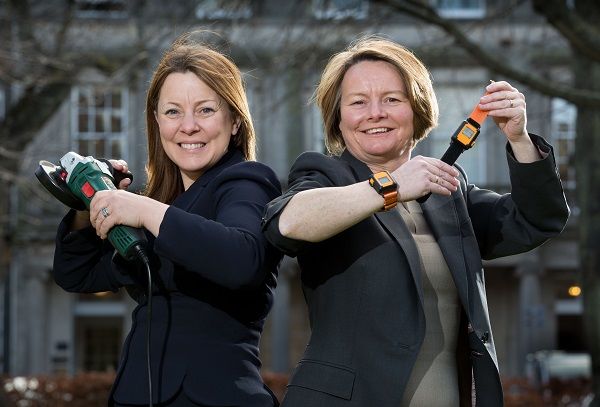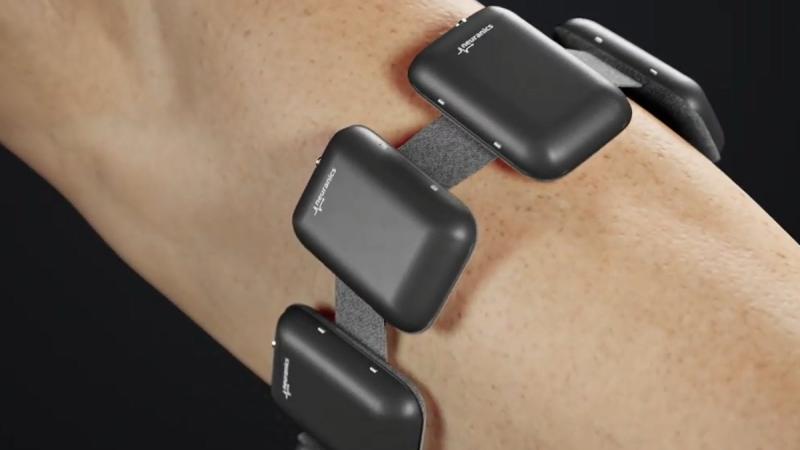
Social distancing solution launched to protect employees returning to work
Edinburgh-based Reactec, has repurposed its proven system for monitoring workers’ exposure to health risk to create “Safedistance”, which enables employers to manage the social distancing of their workforce within construction, rail, manufacturing and other workplaces.
Safedistance is based on an industrial grade wrist-worn device and it:
- Alerts workers if they have strayed to within two metres of a colleague
- Informs employers of the frequency and severity of breaches of social distancing protocols
- Can assist with contact tracing of those who have been close to employees subsequently displaying COVID-19 symptoms
- Can facilitate contact tracing across employers on busy infrastructure projects
- Ring fences work teams who need to work more closely together in controlled cohorts
- Can be expanded to enable real time intervention by a supervisor in the event of social distancing breaches
Jacqui McLaughlin, CEO of Reactec, said:
“Social distancing will clearly be with us for some time and it’s vital that when people get back to work they can do so safely. Our team has moved quickly to repurpose our technology to help businesses to ensure that their teams are working safely.“Reactec, is already dedicated to helping reduce the damage to workers’ health from exposure to vibration, so developing our technology to include social distancing was a logical next step in response to COVID-19. We want to play our part in getting everyone back to work safely and with confidence.”
Reactec has discussed the capabilities of Safedistance at Ministerial level with the Scottish Government. Ivan McKee, Minister for Trade, Investment and Innovation, said:
“In response to this pandemic, companies right across Scotland have been diversifying production lines, increasing capacity or exploring new distribution routes to help deliver what is needed, when it’s needed. Technology is going to play a crucial role in helping us overcome the long-term challenges presented by COVID-19 so it is great to see innovative, dynamic companies repurposing existing technology to help us protect workers from potential exposure in the future.”
More than 45,000 of Reactec’s Hand Arm Vibration (HAV) monitor, HAVwear, on which Safedistance is based, are already in circulation in the UK. Reactec is offering to enable these devices remotely by adding the safe distancing software free of charge – meaning that its existing clients can ensure safe distancing of employees while also continuing to protect them from harmful vibration.
Safedistance was developed by technical experts at Reactec – which is backed by Scottish business angel syndicate, Archangels, and Scottish Enterprise’s investment banking arm, Scottish Investment Bank – as a direct response to the COVID-19 crisis and the Scottish and UK Government’s introduction of social distancing protocols. Recognising that the company had a significant deployment of its existing hardware within its customer base, Reactec mobilised its innovation team to repurpose its product offering. Development work that would normally take months was completed in 15 days, allowing Reactec to test and launch the product in record time. A number of leading companies within the construction and rail sector are now trialling the technology.
One of the companies trialling Safedistance is the leading civil engineering group, Keltbray. Paul Deacy, Managing Director Demolitions and Civils, said:
“Keltbray already uses HAVwear as it’s a robust product and the analytics reporting with its automation and GDPR compliance are critical factors to Keltbray providing actionable intelligence. So when Reactec approached us to trial the new social distance functionality we already had confidence in the product. Keltbray is encouraged by this new offering. This could truly assist us in managing social distancing across our projects.”
The Safedistance technology works by using Bluetooth enabled Reactec devices to detect other Reactec devices within a two-metre range. Should users become closer than two metres apart, both device users are warned with both vibration and audio alerts.
The device is returned to its recharging docking station at the end of each shift, at which point details of any safe distancing breaches are uploaded to the Cloud and combined with other data to produce employer reports to assist in the management of social distancing. All data use is entirely GDPR compliant. The system can be expanded to provide real-time transmission of distancing breaches to enable supervisors to act immediately in managing social distancing.
Jacqui McLaughlin:
“Safedistance is based on a robust, tried and tested personal monitoring technology specifically designed for harsh environments and the strongest requirements of corporate ownership of GDPR compliant data. While the repurposing of the technology to help prevent the spread of COVID-19 is innovative, it is a software amendment to a well-used system. Like everyone else, we long to see the country get back to work and for the economy to be kickstarted once more. I’m confident that Safedistance can play an important part in helping to make this happen.”
Launched in 2016, HAVwear – on which Safedistance is based – is a wearable wrist device that monitors in real time an individual’s exposure to vibration when using power tools. Reactec’s on-line Cloud-based data analytics turns the HAVwear and Safedistance data into manageable intelligence to empower proactive management of risk. HAVwear has enjoyed significant sales since its launch and is in use by a number of leading companies in the UK, including British Airways, Network Rail, Murphy Group, Morgan Sindall, Balfour Beatty, Costain, the Environment Agency, Siemens and Babcock. Reactec’s technology is in use across major infrastructure projects including HS2
Hand Arm Vibration Syndrome (HAVS), which is also known as Vibration White Finger, is one of the most common industrial diseases in the UK. The condition is usually caused by the prolonged use of power hand tools, whose vibrations can damage the blood vessels, nerves, muscles and joints of the hand, wrist and arm. 300,000 people in the UK suffer from the condition, for which there is no known cure, only prevention.





